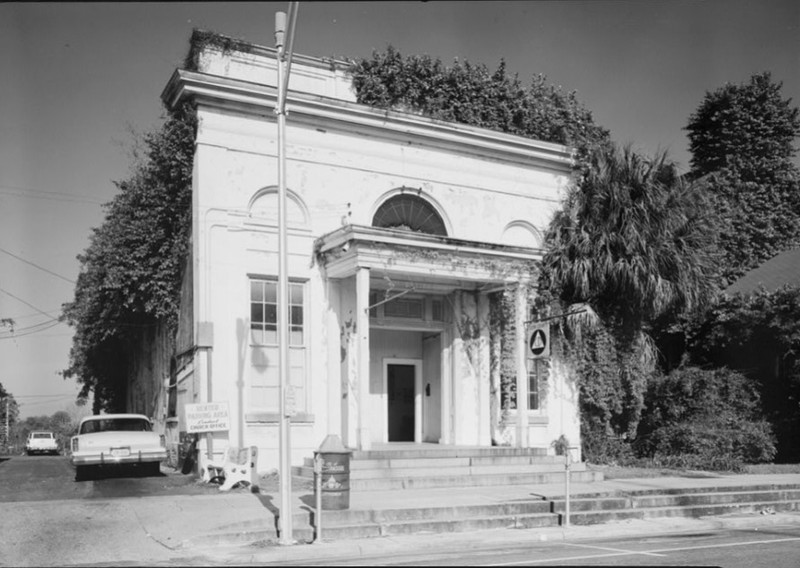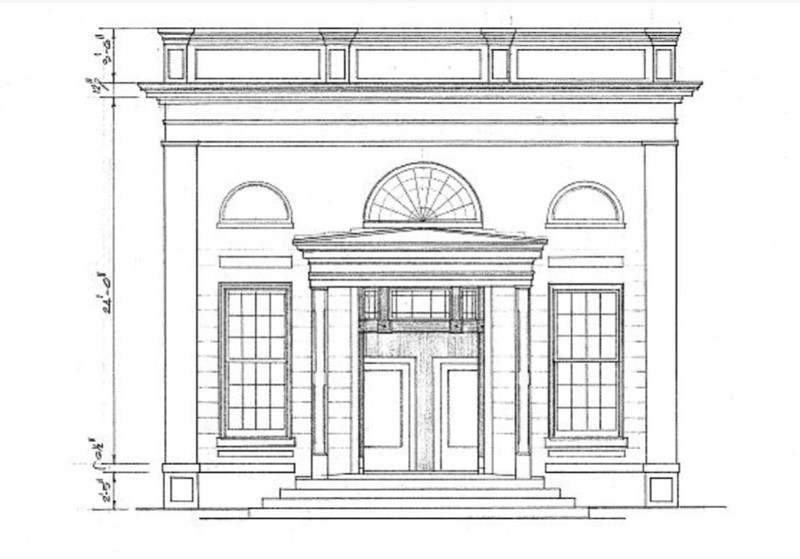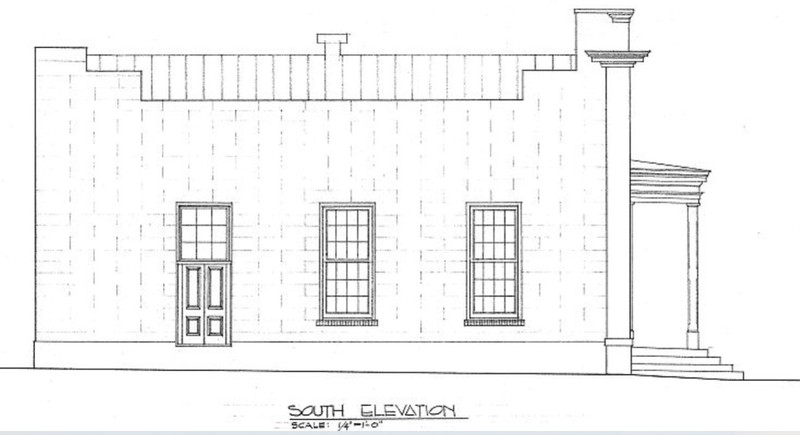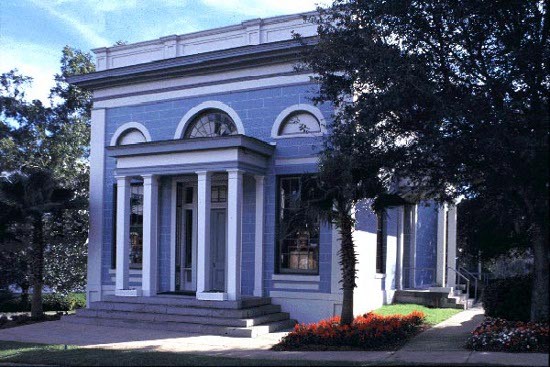Union Bank Museum
Introduction
Text-to-speech Audio
Currently the home of a selection of the Meek Eaton Black Archives' exhibits, the historic Union Bank building is the oldest bank building in Florida. The one-story, Greek Revival style building was constructed in 1841 to specifications found in a contract. It formerly stood at 106 Adams Street and was moved in 1971. The bank closed in the 1840s and reopened after the Civil War as Freedman's Savings and Trust Company in 1868 to serve the emancipated Black population of former slaves. However, it was mismanaged at the national level and was declared a failure in 1874. The building has been used for many functions since the late nineteenth century and was listed in the National Register of Historic Places in 1971. The Archives are open to the public, free of charge.
Images
East facade of Union Bank building in 1962 photo (HABS FL-159)

Measured drawing of front facade of Union Bank building in 1962 (HABS FL-159)

Measured drawing of south elevation of Union Bank building in 1962 (HABS FL-159)

The Black Archives at Union Bank

Backstory and Context
Text-to-speech Audio
Union Bank was established in 1833 by Colonel John G. Gamble, a Virginian who settled in Jefferson County in the Florida Territory in 1827. John Grattan Gamble (1779-1852) was a merchant and planter in Richmond, Virginia and was a superintendent of the new Farmer's Bank of Virginia in 1812. He served in the Richmond Light Infantry Blues during the War of 1812. Besides becoming President of Union Bank after he and his relatives moved to Florida, Gamble also became the postmaster of Jefferson County.
Most of the stockholders in the new Union Bank in Florida were planters and were authorized to take out a bank loan worth up to two-thirds of the value of their stock. The Florida territorial bonds for these loans were secured by mortgages on lands and enslaved persons owned by the stockholders, and totaled $3 million. This proved to be too much of a strain on the bank. After the national Panic of 1837 and subsequent economic downturn, many of the planters could not repay the loans and the bank's powers were suspended by a legislative act in 1843 due to legal issues with the bonds. It became an international affair when British bondholders tried to get the American government to pay up on some of the bonds, but the U.S. claimed it wasn't responsible for the actions of the Florida territorial government.
Following the Civil War, Union troops purportedly stored gunpowder in the former Union Bank building when they occupied Tallahassee. In 1868, the Freedman's Savings and Trust Company opened a branch in Tallahassee in the building. The bank failed in 1874 and depositors were only able to receive a fraction of their deposited funds. The bank branch office closed in 1879. Depositors were advised to mail in their bank book with their current address to receive a dividend by September 1881. In July 1882, about $1600 of the dividends for the Tallahassee Branch's depositors were yet to be claimed. The final and fourth dividend was declared in 1883 and the depositors ended up getting 62% of their money back. State Senator Call introduced a bill in 1888 to reimburse the depositors of the Freedman's Savings and Trust Company for losses incurred by the company's failure—the remaining 38 percent.
The building was said to have been constructed in 1841 by slave labor. The former front porch was a later addition. The front facade features a triple-arch design and a parapet wall. The interior was originally one large space and was later divided into two halves, with two separate entrances on the front of the building. By the early 1960s, a dropped ceiling covered a vaulted space. The building held a dental clinic and a Civil Defense Office in the early 1960s and a bail bond office in the early 1970s. The building was owned by the First Baptist Church of Tallahassee in 1970 and after it was moved, it was owned by Trustees of the Internal Improvement by 1974. It currently houses a museum, which includes an exhibit on the Freedman’s Bank, part of the Meek Eaton Black Archives of Florida A&M University, and exhibits on African-American history; the building is also available for event rentals. It was added to the National Register of Historic Places in 1971.
Sources
Anonymous. "Untitled." The Weekly Floridian (Tallahassee, FL) April 19th 1881. , 2-2.
Anonymous. "Bills Introduced by Senator Call." The Weekly Floridian (Tallahassee, FL) January 5th 1888. , 1-1.
Black Archives at Historic Union Bank, Florida Agricultural and Mechanical University. Accessed January 28th 2021. http://famu.edu/index.cfm?MEBA&TheUnionBank.
Cutler, Henry Gardner. History of Floida, Past and Present, Historical and Biographical. Volume 1. Chicago, IL. Lewis Publishing Company, 1923.
Harlan, Rogers. Greer, Diane P. NRHP Nomination of Union Bank Building, Tallahassee, Florida [new location]. National Register. Washington, DC. National Park Service, 1974.
Knox, John Jay. "Notice to Freedman's Bank Depositors." The Weekly Floridian (Tallahassee, FL) July 25th 1882. 3-3.
Knox, John Jay. "Office of the Commissioner of the Freedman's Savings and Trust Company." The Weekly Floridian (Tallahassee, FL) July 31st 1883. 3-3.
Looney, J. Jefferson. John G. Gamble to Thomas Jefferson, 20 July 1813, Jefferson Papers, Founders Online, National Archives. January 1st 2009. Accessed December 2nd 2020. https://founders.archives.gov/documents/Jefferson/03-06-02-0252.
Schene, Michael G. Robert and John Grattan Gamble: Middle Florida Entrepreneurs. The Florida Historical Quarterly, vol. 54, no. 161 - 73. Published July 1st 1975. Jstor.
Schuck, J. P. NRHP Nomination of Union Bank Building, Tallahassee, Florida. National Register. Washington, DC. National Park Service, 1970.
State Library and Archives of Florida. Historic Union Bank Building museum in Tallahassee, Florida, Florida Memory. Accessed December 2nd 2020. https://www.floridamemory.com/items/show/258824.
https://www.loc.gov/item/fl0129/
https://www.loc.gov/item/fl0129/
https://www.loc.gov/item/fl0129/
http://famu.edu/index.cfm?MEBA&TheUnionBank
